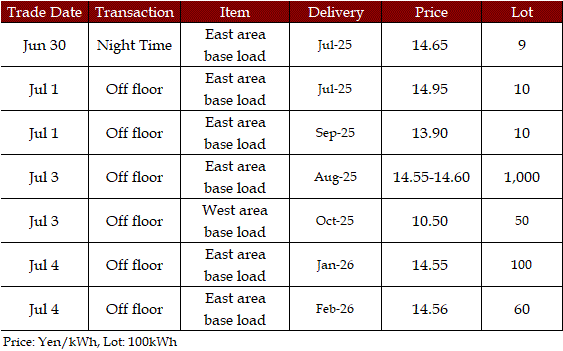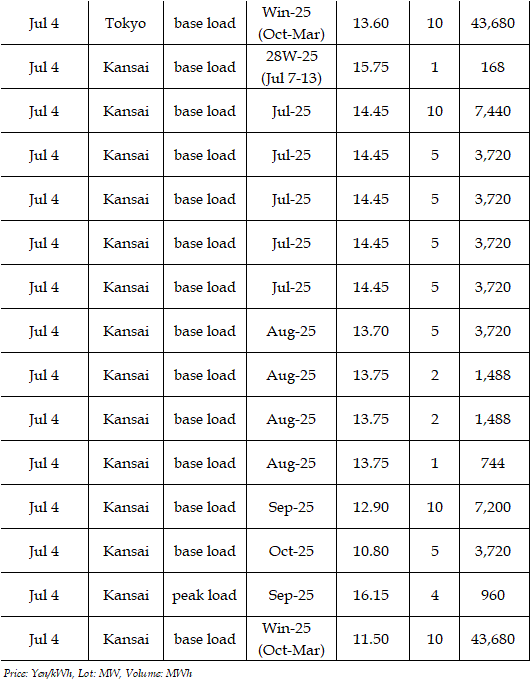Power: Jun 30-Jul 4: Spot prices rise further in East stay sideways in West
|
In the day-ahead market on JEPX (Japan Electric Power Exchange), the 24-hour spot power prices on a weekly average basis for Jun 30-Jul 4 delivery stretched gains slightly from the previous week in East Japan (50Hz) but stayed sideways in West Japan (60Hz). With the arrival of the summer demand season, temperatures in and to the west of the Kanto area recorded above 30 degrees Celsius, with even over 35 degrees in parts of inland Kanto, Tokai, and Kinki (Kansai) areas, pushing up demand for air conditioning. In the Tokyo area, the maximum temperatures hit 50.64 mil kW on Jul 1, exceeding the threshold of 50 mil kW for the first time since last September. Prices, however, did not vary very much from a week earlier because plenty of power in the spot market offset buying interests derived from a spell of scorching weather. Amid this, a tight supply/demand balance was witnessed in the Kansai and Hokkaido areas, where power was shared from other areas on Jul 1 for Kansai and on Jul 2 for Hokkaido. In West Japan, the market was repeatedly separated between Kansai and Chugoku during the daytime, creating a price gap of up to Yen 3 between Chubu, Hokuriku, and Kansai on the one side and Chugoku, Shikoku, and Kyushu on the other. The Chugoku, Shikoku, and Kyushu area are heavily dependent on photovoltaics, creating the trend on sunny days.
In Tokyo and Kansai, the key areas in East Japan and West Japan, the 24-hour average posted a difference in favor of the East by Yen 2.68 for Jun 30 delivery, Yen 2.73 for Jul 1 delivery, Yen 0.64 for Jul 2 delivery, Yen 0.42 for Jul 3 delivery, and Yen 0.69 for Jul 4 delivery.
The fuel market trends in the first week of July were detailed as follows.
DES Northeast Asia spot LNG prices declined further to low $12's per mmBtu for prompt August 2025 delivery as of Jul 3, down about $0.4 from the end of the previous week (Jun 27). A relaxed tension in the Middle East dragged down natural gas prices in Europe; in the DES Northeast Asia market, buying interests remained dull. The Ministry of Economy, Trade and Industry (METI) announced on Jul 22 that Japan's LNG inventories for power generation stood at 2.15 mil mt as of Jun 29, down 120,000mt from a week before. The figure was up both from 2.13 mil mt as of end-June last year and the average of past five years at 2.10 mil mt.
FOB Newcastle thermal coal prices in Australia gained by more than $4.5 from the end of the previous week to the low $111's for July 2025 loading as of Jul 3. High running at coal-fired plants derived from strong power demand in Europe and Asia appeared to raise prices.
In the crude oil market, WTI crude for August 2025 stood in the low $67's per barrel as of the morning of July 3, while Brent crude for September 2025 was trading in the high $68 level. Prices gained by around $1.5 from the end of the previous week for WTI and by around $2 for Brent on the expectation of the recovery of the Chinese economy and the rekindled geopolitical risk in the Middle East. Prices, however, were capped due to the outlook that OPEC Plus would increase supply further in August.
The actual highest price during the week was at Yen 30.00 in four areas, including Hokkaido, Tohoku, Tokyo, and Chubu, for Jul 1 delivery. Meanwhile, the actual lowest price during the week was at Yen 0.02 in Shikoku for Jun 30 delivery.
By area, the weekly average of the 24-hour spot prices was at Yen 13.95 in Hokkaido, up Yen 2.44 from the previous week; Yen 14.57 in Tohoku, down Yen 0.11; Yen 15.79 in Tokyo, up Yen 0.29; Yen 15.38 in Chubu, up Yen 0.31; Yen 14.35 in Hokuriku and Kansai, down Yen 0.61; Yen 12.56 in Chugoku, up Yen 0.26; Yen 12.46 in Shikoku, up Yen 0.16; and Yen 12.52 in Kyushu, up Yen 0.35.
In the JEPX auction, volumes of offers were 1,177.63 mil kWh on a weekly average basis, up 5.9% from the previous week. Meanwhile, bids on a weekly average basis increased by 6.6% to 1,079.09 mil kWh. The weekly average of trade volumes recorded 851.22 mil kWh, up 8.7%.
Power demand in nine areas of Japan during Jun 30-Jul 4 was a combined 13,883.09 mil kWh, up/down 10.1% from 12,605.44 mil kWh during Jun 23-27. The figure was up/down 6.4% from the corresponding period a year earlier. Demand during Jul 1-5, 2024 after day of week adjustment was 13,045 mil kWh.
Deals reported on TOCOM (Tokyo Commodity Exchange) during Jun 30-Jul 4 were as below.
Deals reported on EEX (European Energy Exchange) during Jun 30-Jul 4 were as below.
In the second week of July, spot prices have been expected to rise from the first week of July. In and to the west of the Kanto area, a spell of over 35-degree days has been expected, increasing buy orders in the spot market. The return of thermal power plants from maintenance in the latter half of the week, however, would mitigate the upside momentum to some degree, along with the strong photovoltaic outputs, which will put a lid on the daytime through the next week. Amid this, a source at a power producer and supplier said, "With a spell of scorching weather, more players will move to buy due to worries about imbalance. As a result, some buyers may place a bid at above the market price so that they don't miss the procurement." The source then added, "I guess the base prices will go up by Yen 1-2 from the first week to Yen 17-18 in the Tokyo area, whereas those in the Kansai area, where a supply/demand balance is tight, will increase beyond Yen 16."
|
||||||||||||||||||||||||||||||













